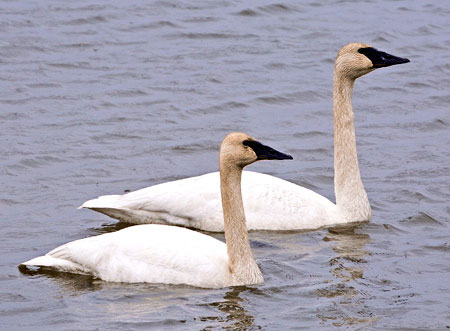
Alaska Science Pondering the future of Alaska landscapes
October 03, 2008
Trumpeter swans, a species that may find the Alaska of the future offers more of the ice-free days they need to hatch and raise their young. This may be the Alaska of 2099. Or it may not. However, this is the best-guess scenario of researchers who used climate models and all the relevant information they could find to predict the future of Alaska landscapes, how the state’s ecosystems may change, and how all that could affect four different species in Alaska. Karen Murphy and John Morton of the U.S. Fish and Wildlife Service and the University of Alaska Fairbanks’ Nancy Fresco and Falk Huettmann compiled the report with the help of many others. The team used data from Alaska weather stations to prime the best computer models representing climate. The data was combined with the knowledge of scientists with years of field experience. Murphy, Morton, Fresco and Huettmann chose to look at caribou because those animals exist all over the state and so many people depend upon them for food; Alaska marmots because they can probably thrive nowhere else but their high-country habitats in Alaska; trumpeter swans because they are a migratory bird that can choose their own places to nest based in part on ice-free days; and reed canary grass because it is an invasive weed species that already has a toehold on the Kenai Peninsula. With many cautionary notes in their report about the reliability of attempting to predict the future with computer models (which is problematic, just ask your weatherman), the researchers drew maps showing the predicted future ranges of caribou, Alaska marmots, trumpeter swans and reed canary grass. Their predictions for 2090-2099 show less ideal Alaska habitat for the Alaska marmot and caribou, and more for trumpeter swans and reed canary grass. The report is for “anyone who has to make decisions about long-range management planning, primarily land managers,” said Fresco, network coordinator of the Scenarios Network for Alaska Planning at UAF. She advised against people taking the predictions as the way things are going to be. “It was the best we could do given the data at the time,” she said. “All the projections have to be taken with all the caveats. These are possible scenarios, but we’re not trying to lock ourselves into saying it’s going to happen this way or that way.” The report, “Connecting Alaska Landscapes into the Future,” is more of a new way to look at things than a management tool, said Tom Paragi, a wildlife biologist with the Alaska Department of Fish and Game who helped group members compile information about caribou. “It’s a way to test hypotheses,” he said. “In the next 10 to 20 years, let’s see if there’s evidence of change toward these scenarios . . . It’s a different way of thinking long-term, but it’s nothing we take and run with right now.” Fresco said group members are now working on more detailed reports for both Alaska and Canada. “We’re trying to do more of the same with better and more data,” she said, adding that even though the projections aren’t perfect, they might inspire people to look ahead. “All planning involves uncertainty,” she said. “Using uncertainty as an excuse to avoid thinking about the future is not usually the best option.”
This column is provided as a public service by the Geophysical Institute, University of Alaska Fairbanks, in cooperation with the UAF research community. Ned Rozell [nrozell@gi.alaska.edu] is a science writer at the institute.
Publish A Letter in SitNews Read Letters/Opinions
|
